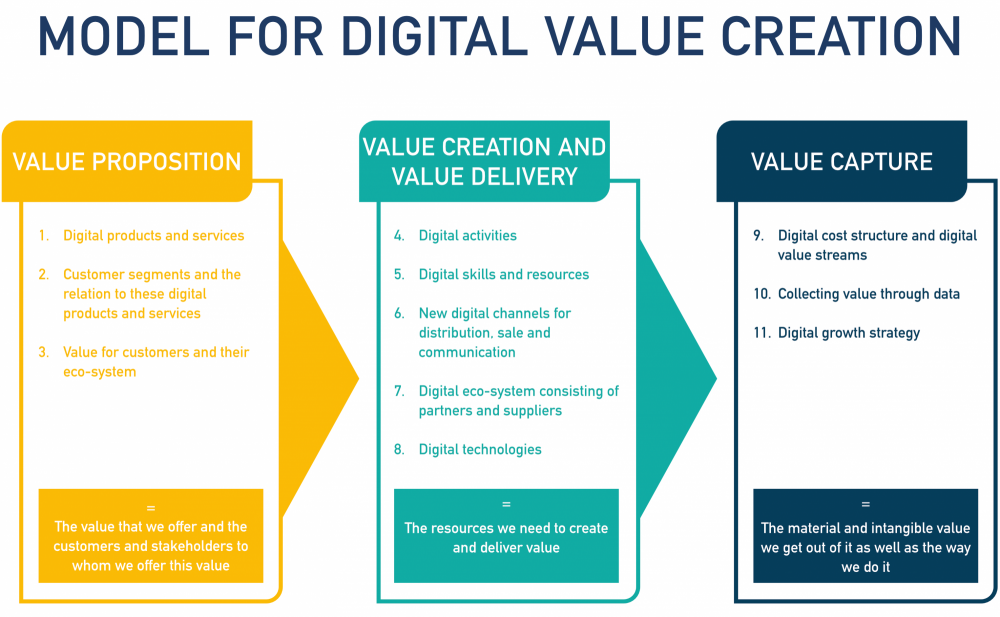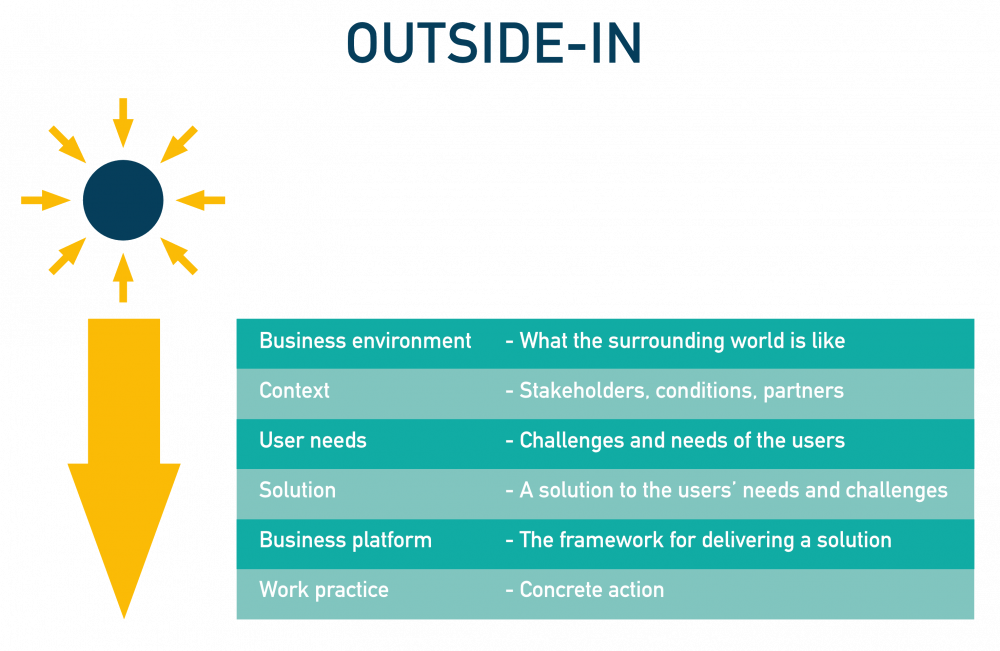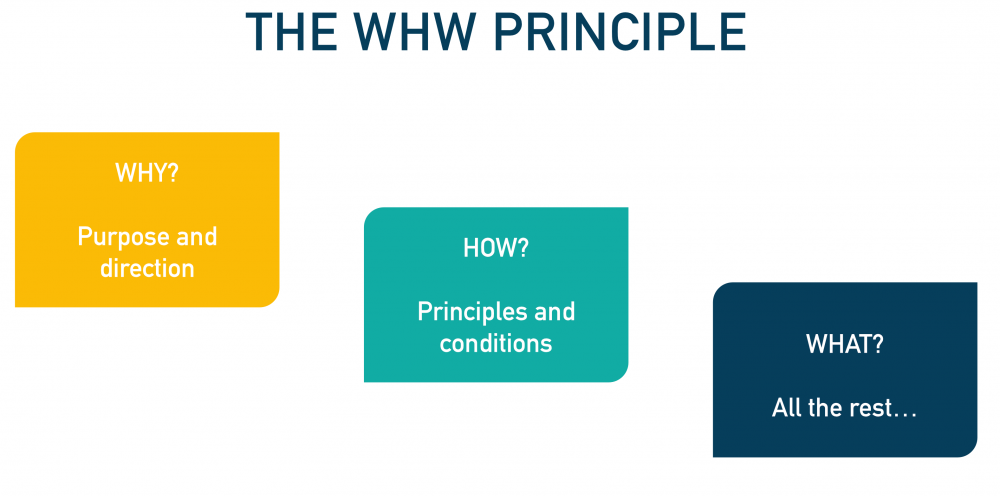
April 4, 2022
Before you start
This learning module is part of the building block:
The module – in brief
The module introduces an overall understanding of a business model and some basic principles that are worth applying when working with digital business models development and digital transformation in general. The keyword in business model innovation is value – value for the company behind the business model, the customers, the users and other parties involved in the business model. All methods and tools introduced in this toolbox are based on the understanding and principles presented in this module.
What is value?
Once you have completed your Pre-analysis of the surrounding world and Pre-analysis of the company’s situation, and perhaps drawn inspiration from current or new trends via the Customer analysis, you are ready to move on to designing a digital business model, which is the focal point of the entire process. However, to get started, you need some fundamental knowledge about business models.
Very simply, a business model can be described as:
The way in which a company creates value and makes money from it.
The business model thus describes how the individual pieces of the business are connected in a system. See the illustration Model for digital value creation below.

“Model for digital value creation” by Annabeth Aagaard (2019)
Value proposition, value creation and delivery as well as value capture are common elements across the various tools you can use to describe your company’s Current business models or to design New digital business models:
- Value proposition
You must ensure that your business model offers value for a specific customer segment or user group. Of course, what is perceived as valuable depends on who the recipient is. Often, value can be a solution to a specific problem or something that fulfils a need and thus provides value to the recipient. - Value creation and delivery
For the customer or user to gain value from a digital product or service, a number of practical activities must take place along the way. In the business model, you should therefore also explain the practical steps; e.g. resources, knowledge and technology needed to develop or produce the solution. Likewise, the digital solution must be delivered to the customer, which may involve a network of partners, a distribution system or something else entirely. - Value capture
Last but not least, the business model description must explain how the company will capture value through its activities. The type of value you want to achieve with the business model may vary. Examples include profit, customer growth, a greener bottom line or knowledge in the form of data as part of the digital growth strategy.
This and several other fundamental principles of business development are further described in the video here.
"Business Model Innovation" by CyPro available under licensen CC BY-NC-ND.
The outside-in principle
In a digitally connected world, it is essential for businesses to understand and respond to market and customer needs. This is the essence of the outside-in principle, which emphasises that a company must adapt to external conditions instead of focusing solely on internal goals. Customers have more choices than ever, and companies must adjust to meet their evolving needs. Value creation in this context is not just about offering a product or service but about responding to what customers need – and are willing to pay for.
The outside-in principle encourages companies to consider the broader market first and then tailor their solutions to customer needs. Value alignment is key: your company’s goals must align with what the customers want, as this alignment determines your success in creating sustainable value.

“Outside-in” adopted from Digital Business Models for the Future under license CC BY-SA 4.0
The outside-in principle gives you an overview of how to analyse the surrounding world as a whole, then the market, next the customers and possible solutions for the customers. When you start researching possible business models in order to create solutions for customers, you have reached the point where customer demands (and associated willingness to pay) meet your business goals (and associated profit requirements). Based on a potential business model, your analysis shifts to your company and examines what it takes to deliver solutions to customers in the market.
The why-how-what principle
The WHW principle is essential for developing a strategic foundation for any digital transformation. Why you are doing something must guide the entire process, ensuring that value creation is the ultimate goal. Only when the purpose is clear can you move on to how to achieve it and then determine what specific actions to take.

“The WHW principle” adopted from Digital Business Models for the Future under license CC BY-SA 4.0
Regardless of the project or change you embark on, being clear about why you are doing it is crucial for success. It seems obvious and straightforward, but many companies start projects without clearly defining their purpose. In practice, many companies start from behind by focusing on what they need to do (activities and tasks) and what they need to apply (technology, resources, competencies) before having a clearly defined purpose. This is akin to packing a suitcase before deciding on a destination.
Therefore, the first question should always be why: Why should we develop a digital business model and work with digital transformation? Define the overall purpose of doing something at all. The purpose can take many forms, such as maintaining competitiveness against new companies in the market, attracting a new type of customer or something completely different. If multiple purposes exist, formulate and write them down separately and then carefully consider whether you should tackle them all at once or prioritise them. Only when you have clearly and unambiguously formulated and written down your why, it is relevant to start thinking about how to approach the task.
The how is about strategy, tactics and method. For example, when we want to strengthen our competitiveness in the market (why do we want to develop our business digitally?), should we do this by digitally streamlining all processes or by offering new digital services that can attract customers (how do we want to achieve our purpose?)?
While it is recommended that you formulate one why at a time, you will likely find several how-answers to each why. Often, the answer to how will be a series of strategic moves that need to be executed one after the other. Ensure that the answers to how collectively form a coherent and logical recipe for how you can achieve your purpose – and make sure to write everything down. When you have formulated your how as an overall recipe for achieving your purpose, you can start thinking about what specific actions to take.
The what determines the specific tasks, technologies and resources required to implement the strategy. All decisions about what should be driven by the overarching goal of creating and delivering value. The what can contain an infinite number of elements. However, you should not make a what-decision regarding technology, tasks, activities, resources, etc. unless you can identify a corresponding how-point that it is meant to support. It is also crucial to remember that you must not formulate any how-points that do not clearly align with your whys.
Therefore, the WHW principle is useful for addressing these critical questions and ensuring that they are approached in the correct sequence. Why establishes the direction, avoiding the pitfall of focusing solely on particular technologies or work methods. At the same time, it facilitates effective communication about the digital change: Why do we do it? How is it going to take place? What exactly needs to be done, with which technology, by whom and when?
The holistic principle
One might assume that digital business development revolves around technology. However, when businesses want to develop digitally, the process must start by defining their value proposition, followed by establishing the necessary organisational structure to support it. Only then should technology be selected with the aim of supporting the business and organisation. The holistic principle ensures that all parts of the company work together towards the common goal of value creation.
Initiate the process by considering the business aspect: What business value do you want to achieve? Do you want to tighten and streamline your business processes to become almost fully automated? Do you want to create new value with digital services alongside your physical products? What should drive you are clear business goals, because if your idea lacks a business foundation, you need to rethink it.
Once a business goal is defined, the next consideration involves the organisation. How do we organise ourselves in terms of processes, management, roles and competencies to realise the business value we aim to achieve? If you cannot find solutions to the organisation, you will not be able to realise your business goal. In that case, you will need to come up with another business goal that is actually achievable.
Only when a business goal is clearly defined and organisationally feasible, you can start considering how it can be supported with technology. Finally, you should consider how it can all be sustained with quality. All elements must work together and interact with each other.
If you think that the ‘business, organisation, technology and quality formula’ of the holistic principle is a bit like the why-how-what principle, you are absolutely right. While these principles emphasise different aspects, both prioritise the business purpose as the guiding principle. Operational methods act as glue, ensuring that technological and quality decisions along with specific tasks are grounded in the prior considerations.
Holistic thinking
Digitalisation connects the whole world and individual companies in completely new ways, and digital value arises precisely through this connectedness. This also means that within the individual company, digital business and digital business development span across departments, organisational layers, processes, professional groups, systems, topics and work tasks. Therefore, holistic thinking is necessary if you want to create and harvest digital value.
The methods and tools presented in this toolbox uniquely contribute to fostering holistic thinking in digital business development. For example, further analysis is essential to assess the external environment and market as well as to design services centred around customer needs, while simultaneously viewing the entire company through the lens of digital transformation.
Iterative and agile thinking
In a world where technology, markets and customer expectations are evolving at an increasingly rapid pace, adopting an iterative and agile approach offers a clear advantage. This involves working in small cycles, where tasks or a set of tasks are completed continuously, each creating value, while learning from experience and making adjustments with every cycle. This approach makes development and implementation more manageable, flexible and focused on delivering results.
Today, if a company sets itself a long-term goal, it is necessary to also set many smaller sub-goals, which not only lead to the ultimate goal but also provide value along the way. This is because it is far from certain that you will ever reach your long-term goal – or that you should want to achieve it – as the world is changing so rapidly and dramatically that one goal is rarely relevant for very long. Instead, the focus is on rapidly launching services, processes and business models that deliver immediate value.
All methods and tools presented in this toolbox are tailored to support iterative and agile methodologies. These methodologies promote experimentation, rapid development, implementation and subsequent learning across successive cycles of innovation, development and implementation.
Multi-business models
By knowing and following the overall understanding and basic principles outlined for digital business model development and digital transformation, you will be able to reinforce value as the cornerstone of your business model.
It is essential, however, to recognise that the vast majority of companies operate several business models simultaneously – multi-business models. If a company offers products and services that target different customer segments or address different needs within the same segment, it makes sense to adopt distinct business models for these products and services.

“Multi Business Models” adapted from the “St. Gallen Magic Triangle” by (Gassmann et. al, 2019)
Having multiple business models enables you to view your business more flexibly and provides greater readiness for change. It also helps to reduce risks in the business, as it allows for greater agility, with new business models being developed and tested. Likewise, business models that have proven less profitable may be phased out while others take over. Business models related to the company’s core products can be combined with new digital services in business models that bring existing customers closer to the company and provide competitive advantages to new customer segments.
Every time you offer a solution (value proposition) to a customer segment, you should therefore establish a dedicated business model. While each business model has its own individual value pieces, it should still follow the overall understanding and basic principles presented in this module.
Next step
On the learning platform, you will find modules that describe the various tools for developing, testing and implementing a new digital business model from the company’s current position. If you need further inspiration, our case studies provide examples of innovation in existing business models.
When you are ready to work with your own business model, a good place to start is with value design as part of the module Service design.
You can also begin with a deeper dive through a Pre-analysis of the surrounding world and a Pre-analysis of the company’s situation to gain insight into the opportunities and threats surrounding your company externally as well as the prerequisites it has internally.

The content elements above have been developed through two projects:
‘Digital Business models for the Future’ by Aarhus University, Aarhus School of Marine and Technical Engineering and Danish Technological Institute supported by The Danish Industry Foundation. The material from this project has been adopted in alignment with CC BY-SA 4.0
‘EU-IoT’ by Aarhus University, Martel Innovate, Netcompany-Intrasoft, Fortiss, BluSpecs and funded by the Horizon 2020 Framework Programme under topic ID ICT-56-2020, grant ID 956671.

You have completed the entire building block
Get your certificate for this completed building block. Request the certificate and we will send you the personal certificate.



